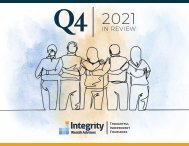You also want an ePaper? Increase the reach of your titles
YUMPU automatically turns print PDFs into web optimized ePapers that Google loves.
A SURPRISINGLY RESILIENT ECONOMY DESPITE<br />
A HAWKISH FED<br />
<strong>2023</strong><br />
<strong>Q3</strong><br />
IN REVIEW<br />
The financial markets faced significant challenges in the third quarter.<br />
Equities struggled as a bearish sentiment took hold in recent months. The<br />
initial momentum, driven by a disinflation narrative from October 2022 to July<br />
<strong>2023</strong>, was overshadowed by less supportive storylines, leaving equities in a<br />
precarious position amidst the resilient economy.<br />
Despite efforts, inflation improvement remains elusive due to persistent wage<br />
stagnation. While U.S. consumers didn't cause the pandemic-related price<br />
surge, they are now demanding higher wages. This robust labor force is a<br />
reason why the Federal Reserve is cautious in easing its policies, hinting at<br />
a prolonged period of restrictive measures, which is impacting both equities<br />
and bonds.<br />
This tightening of financial conditions is happening in an economy that,<br />
at the moment, seems capable of absorbing it. Consumers are financially<br />
stable, employment markets are robust, corporate profits are rising, and fiscal<br />
policies are surprisingly pro-cyclical for this stage of expansion. Consequently,<br />
the rise in yields seems justified given the resilient economy and the hawkish<br />
stance of the Fed. While the threat of a recession looms in 2024, for now, the<br />
market's fate hangs on oil prices and the U.S. 10-year Treasury yield.<br />
Traditionally, interest rates would be at new lows during this expansion<br />
phase, stimulating the economy through refinancing and increased housing<br />
demand. However, investors are now grappling with a gradual reduction in<br />
liquidity, reflected in the narrowing gains across financial assets. Despite<br />
healthy nominal economic growth, the ongoing contraction of money and<br />
credit implies a limited shelf life for this prosperity. <strong>In</strong>vestors remain skeptical<br />
about the soft-landing theory unless there's a significant change in the current<br />
scenario. The longer the economy stays resilient, the higher the chances of a<br />
harsher economic downturn.<br />
Real interest rates are higher, emphasizing the time value of money and<br />
marking a departure from the post-2008 era of easy money. Consequently,<br />
considering valuations is crucial in investment decisions. The era of pursuing<br />
growth at any cost is becoming increasingly difficult to justify.<br />
ECONOMIC CHARTS & NOTES<br />
CONSUMER SENTIMENT Consumer sentiment improved in <strong>Q3</strong>, reaching its<br />
highest level in nearly two years, although autoworker strikes and the government<br />
shutdown added uncertainty. Retail sales picked up as American shoppers stayed<br />
resilient.<br />
US Retail Sales<br />
Consumer Sentiment<br />
EMPLOYMENT The U.S. unemployment rate rose to 3.8% (its highest level since<br />
February 2022), a sign that the jobs market may be cooling. Job gains were better<br />
than expected in August, led by healthcare, but June/July figures were revised lower.<br />
Unemployment Rate<br />
NonFarm Payroll<br />
34%<br />
100<br />
16%<br />
2200<br />
US Retail Sales % Chg<br />
28%<br />
22%<br />
16%<br />
10%<br />
4%<br />
-2%<br />
-8%<br />
90<br />
80<br />
70<br />
60<br />
Consumer Sentiment<br />
Unemployment Rate %<br />
14%<br />
12%<br />
10%<br />
8%<br />
6%<br />
4%<br />
-825<br />
-3850<br />
-6875<br />
-9900<br />
-12925<br />
-15950<br />
-18975<br />
NonFarm Payroll<br />
-14%<br />
Jan '19<br />
Jul '19<br />
Jan '20<br />
Jul '20<br />
Jan '21<br />
Jul '21<br />
Jan '22<br />
Jul '22<br />
Jan '23<br />
50<br />
Jul '23<br />
2%<br />
Jan ' 19<br />
Jul '19<br />
Jan '20<br />
Jul '20<br />
Jan '21<br />
Jul '21<br />
Jan '22<br />
Jul '22<br />
Jan '23<br />
Jul ' 23<br />
-22000<br />
Source: University of Michigan Consumer Sentiment. Retail Sales - U.S. Census Bureau.<br />
Source: U.S. Bureau of Labor Statistics














